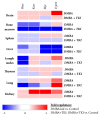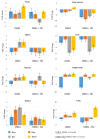Tyrosine Kinase Inhibitor Imatinib Mesylate Alters DMBA-Induced Early Onco/Suppressor Gene Expression with Tissue-Specificity in Mice
- PMID: 30882001
- PMCID: PMC6383434
- DOI: 10.1155/2019/8670398
Tyrosine Kinase Inhibitor Imatinib Mesylate Alters DMBA-Induced Early Onco/Suppressor Gene Expression with Tissue-Specificity in Mice
Abstract
Tyrosine kinases play crucial roles in cellular development and tumorigenesis. Tyrosine kinase inhibitors (TKIs) are effective and widely used drug molecules in targeted cancer therapies. Altered expressions of protooncogenes and tumor suppressor genes after DMBA (7,12-dimethylbenz[a]anthracene) treatment have been described as early markers of tumor induction; however their tissue-specific effects remain still unclear. Our study was aimed at examining the short-term possible antineoplastic and chemopreventive effects of a TKI compound (imatinib mesylate) on a DMBA-induced mouse tumor model. In addition, we also investigated the tissue-specific expressions of Hras, Kras, Myc, and Trp53 genes in the brain, bone marrow, spleen, liver, abdominal lymph nodes, thymus, lungs, and kidneys, respectively. 24 hours after the imatinib mesylate injection, we observed significant Kras downregulation in the bone marrow and lung of the DMBA-treated mice. Moreover, the mRNA expression of Myc was also found to be decreased significantly in the spleen. Interestingly, while Trp53 expression was significantly increased in the lung, it was decreased in the other tissues. However, there was also a tendency in the decreased Myc level in the bone marrow, brain, kidneys, lungs, and lymph nodes and in the decreased Hras level in the bone marrow, kidneys, and lungs, although no significant differences were observed. Our findings indicate rapid tissue-specific impact of imatinib mesylate on DMBA-induced gene expression in vivo, supporting the chemopreventive potential of imatinib mesylate in cancer.
Figures




Similar articles
-
Effect of E-2-(4'-methoxybenzylidene)-1-benzosuberone on the 7,12-dimethylbenz[alpha]anthracene-induced onco/suppressor gene action in vivo. I: A 24-hour experiment.Anticancer Res. 2000 Jan-Feb;20(1A):475-81. Anticancer Res. 2000. PMID: 10769699
-
Early modification of c-myc, Ha-ras and p53 expressions by chemical carcinogens (DMBA, MNU).In Vivo. 2009 Jul-Aug;23(4):591-8. In Vivo. 2009. PMID: 19567395
-
Effect of E-2-(4'-methoxybenzylidene)-1-benzosuberone on the 7,12-dimethylbenz[alpha]anthracene-induced onco/suppressor gene action in vivo II: A 48-hour experiment.Anticancer Res. 2000 May-Jun;20(3A):1839-48. Anticancer Res. 2000. PMID: 10928116
-
Drugging "undruggable" genes for cancer treatment: Are we making progress?Int J Cancer. 2021 Jan 1;148(1):8-17. doi: 10.1002/ijc.33197. Epub 2020 Aug 7. Int J Cancer. 2021. PMID: 32638380 Review.
-
Is sunitinib a Narrow Therapeutic Index Drug? - A systematic review and in vitro toxicology-analysis of Sunitinib vs. Imatinib in cells from different tissues.Regul Toxicol Pharmacol. 2016 Jun;77:25-34. doi: 10.1016/j.yrtph.2016.02.010. Epub 2016 Feb 23. Regul Toxicol Pharmacol. 2016. PMID: 26924275 Review.
Cited by
-
Imatinib Mesylate Induces Necroptotic Cell Death and Impairs Autophagic Flux in Human Cardiac Progenitor Cells.Int J Mol Sci. 2022 Oct 5;23(19):11812. doi: 10.3390/ijms231911812. Int J Mol Sci. 2022. PMID: 36233113 Free PMC article.
-
Monitoring imatinib decreasing pericyte coverage and HIF-1α level in a colorectal cancer model by an ultrahigh-field multiparametric MRI approach.J Transl Med. 2024 Jul 31;22(1):712. doi: 10.1186/s12967-024-05497-w. J Transl Med. 2024. PMID: 39085929 Free PMC article.
-
Imatinib Sets Pericyte Mosaic in the Retina.Int J Mol Sci. 2020 Apr 5;21(7):2522. doi: 10.3390/ijms21072522. Int J Mol Sci. 2020. PMID: 32260484 Free PMC article.
References
MeSH terms
Substances
LinkOut - more resources
Full Text Sources
Research Materials
Miscellaneous

